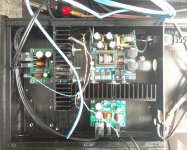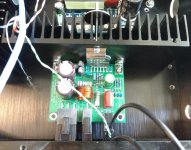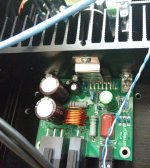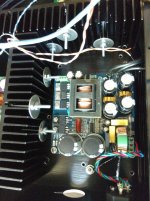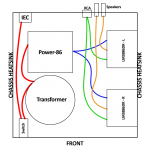Very impressed that the documentation acknowledges that not everyone is in North America and provides options for us Europeans.
You're welcome. Yeah. I have builders world-wide and I try to accommodate as many as possible.
Only slight concern was that the transformer hummed slightly. I'd welcome thoughts as to what might be causing that.
It could be the light load, though the more probable reason is DC on the mains. I wouldn't worry too much about it. If it's still there when you get the amp hooked up and it still bothers you, I suggest building a DC blocker (made from a diode bridge and a capacitor).
Tom
Sometimes, if the hum is very faint, simply mounting the transformer properly with rubber rings reduces it even further. And once inside a box a few meters away...
If interested in dc blocker: Mains DC and Transformers
If interested in dc blocker: Mains DC and Transformers
I bought these nearly six months ago. Waited a month or two to assemble them. Then waited another month or two to do the (lousy) mechanical work. And only this weekend did I actually power them on. To be honest I had low expectations: not in any way due to Tom's design, but just given that the lm3886 isn't exactly new tech by any means. I don't know if this technically qualifies as a Gainclone, but it certainly bears a strong family resemblance if nothing else. But I felt compelled to give a "classic" chipamp like the lm3886 a try, if only to check it off my diyAudio bucket list.
I have to say: so far I'm really liking the way these sound! I'm typically a class-D guy, mainly for size/efficiency reasons. But I realized that at my modest listening levels, combined with a small room, and fairly efficient speakers, that I'm operating at such low power levels, the class D stuff actually isn't getting into the impressive part of the efficiency curve. Likewise, this pair of lm3886s isn't being pushed too hard, so the (relative) inefficiency isn't getting a chance to show its head.
That case was recycled from another project. The heatsinks are cheapies from ebay. I didn't tap them, and instead took the ghetto bolts and washers approach you can see in the pics. These sound good enough that I think I'm going to spring for a proper case, and do a better job with the heatsink mounting. You can also see the actual lm3886dr modules are too close to the chassis, putting some strain on the wires.
That's a Connex Electronic SMPS300RE at +/-28V by the way.
Speaking of efficiency, I've got a Kill-a-Watt AC meter on this. At my usual listening levels, I'm pulling around 10 watts. For comparison, the tpa3251 amp I usually use in this role pulls about 4 watts at typical levels. That's a significant difference in terms of percentages obviously, but in absolute wattage it's not a big deal.
I have to say: so far I'm really liking the way these sound! I'm typically a class-D guy, mainly for size/efficiency reasons. But I realized that at my modest listening levels, combined with a small room, and fairly efficient speakers, that I'm operating at such low power levels, the class D stuff actually isn't getting into the impressive part of the efficiency curve. Likewise, this pair of lm3886s isn't being pushed too hard, so the (relative) inefficiency isn't getting a chance to show its head.
That case was recycled from another project. The heatsinks are cheapies from ebay. I didn't tap them, and instead took the ghetto bolts and washers approach you can see in the pics. These sound good enough that I think I'm going to spring for a proper case, and do a better job with the heatsink mounting. You can also see the actual lm3886dr modules are too close to the chassis, putting some strain on the wires.
That's a Connex Electronic SMPS300RE at +/-28V by the way.
Speaking of efficiency, I've got a Kill-a-Watt AC meter on this. At my usual listening levels, I'm pulling around 10 watts. For comparison, the tpa3251 amp I usually use in this role pulls about 4 watts at typical levels. That's a significant difference in terms of percentages obviously, but in absolute wattage it's not a big deal.
Attachments
So, with the wait until some of the remaining components and connectors arrive from Mouser, my mind has turned to the chassis since I can get on with this in the meantime.
I've gone for a Mini Dissipante chassis from Modushop. This has the heatsinks built in to both sides. The variant I have gone for has internal dimensions of 10" x 10" (250mm x 250mm). I think I could have squeezed it into a slightly smaller chassis, but space isn't an issue particularly so I thought I've give myself a little more breathing space.
At first glance, the obvious way to try and lay things out is to place one amplifier board onto each of the sides. However, since the IEC will be at the back running to a switch at the front, this means running the mains power either beside one of the amplifier boards, or down the middle of the chassis.
Since the chassis heatsinks are rated at 0.47 °C/W, it seems that just one of the heatsinks could cope easily with both amplifier boards. With that in mind, I've come up with the attached layout (pretty much to scale I think). Does this seem sensible or should I revert to one amplifier board per heatsink?
Neil
I've gone for a Mini Dissipante chassis from Modushop. This has the heatsinks built in to both sides. The variant I have gone for has internal dimensions of 10" x 10" (250mm x 250mm). I think I could have squeezed it into a slightly smaller chassis, but space isn't an issue particularly so I thought I've give myself a little more breathing space.
At first glance, the obvious way to try and lay things out is to place one amplifier board onto each of the sides. However, since the IEC will be at the back running to a switch at the front, this means running the mains power either beside one of the amplifier boards, or down the middle of the chassis.
Since the chassis heatsinks are rated at 0.47 °C/W, it seems that just one of the heatsinks could cope easily with both amplifier boards. With that in mind, I've come up with the attached layout (pretty much to scale I think). Does this seem sensible or should I revert to one amplifier board per heatsink?
Neil
Attachments
Since the chassis heatsinks are rated at 0.47 °C/W, it seems that just one of the heatsinks could cope easily with both amplifier boards. With that in mind, I've come up with the attached layout (pretty much to scale I think). Does this seem sensible or should I revert to one amplifier board per heatsink?
Check out blackskull's Modulus-86 build in the other thread. He used the 300mm depth version of the mini dissipante, but went for the same layout you are proposing. Presumably works OK.
I've been using the my LM3886DR amp for almost a year now but unfortunately I have to come back to addressing a hum/noise issue I am having. There have been a few suggestions from Tom and scottjoplin (thank for pointing me to Earthing (Grounding) Your Hi-Fi - Tricks and Techniques) and I have done my best to go through all of it - unfortunately no success so far.
I'll try another shot at this and would be most thankful for your help.
The current situation:
The LM3886DR is installed in an enclosure together with an SMPS86 power supply. Grounding according to Tom's manuals. I used to have a volume pot in there but removed it recently to control volume with a Pass B1 preamp. I thought the Volume Pot might have been the culprit but removing it didn't change anything. Actually things got bit worse as now the hum/buzz is louder. It seems the hum/buzz originated from somewhere "in front" of the pot as it was then attenuated before it got to the 3886 amplifier. Now that there's no pot the noise floor is at full volume all the time.
The hum/buzz gets louder the more I connect to the amps input. For example:
Amp turned on, nothing connected at inputs: very faint noise.
Amp turned on, RCA cables plugged in (loose ends, no source): noise gets louder.
Amp turned on, source connnected: noise gets even louder.
For the last point (source connected) it will make no difference whether i plug in the B1 preamp, a phono stage, iPod, etc.... the noise will increase by the same amount. The noise will also increase if the source is switched off.
Earlier on Tom suggested lifting the ground. I tried that without success. Although I am not sure if it would be enough to remove the cable that runs from the grounding lug to the chassis. I suspect that the chassis is also connected to ground via one of the mounting screws. Tom, can you comment on that?
As mentioned earlier I read through the grounding article on the ESP site and this comment on SMPS really grabbed my attention:
"Switchmode supply noise and any high frequency noise on the mains now flows in the shield of the interconnect. This is not really an earth loop as such, and the result is more likely to be a harsh (grating) hissing sound. It is quite distinctly different from normal thermal noise, and is also more intrusive."
Could this be the issue?
I know this is a very long post and I thank you guys in advance for any suggestions you might have.
I'll try another shot at this and would be most thankful for your help.
The current situation:
The LM3886DR is installed in an enclosure together with an SMPS86 power supply. Grounding according to Tom's manuals. I used to have a volume pot in there but removed it recently to control volume with a Pass B1 preamp. I thought the Volume Pot might have been the culprit but removing it didn't change anything. Actually things got bit worse as now the hum/buzz is louder. It seems the hum/buzz originated from somewhere "in front" of the pot as it was then attenuated before it got to the 3886 amplifier. Now that there's no pot the noise floor is at full volume all the time.
The hum/buzz gets louder the more I connect to the amps input. For example:
Amp turned on, nothing connected at inputs: very faint noise.
Amp turned on, RCA cables plugged in (loose ends, no source): noise gets louder.
Amp turned on, source connnected: noise gets even louder.
For the last point (source connected) it will make no difference whether i plug in the B1 preamp, a phono stage, iPod, etc.... the noise will increase by the same amount. The noise will also increase if the source is switched off.
Earlier on Tom suggested lifting the ground. I tried that without success. Although I am not sure if it would be enough to remove the cable that runs from the grounding lug to the chassis. I suspect that the chassis is also connected to ground via one of the mounting screws. Tom, can you comment on that?
As mentioned earlier I read through the grounding article on the ESP site and this comment on SMPS really grabbed my attention:
"Switchmode supply noise and any high frequency noise on the mains now flows in the shield of the interconnect. This is not really an earth loop as such, and the result is more likely to be a harsh (grating) hissing sound. It is quite distinctly different from normal thermal noise, and is also more intrusive."
Could this be the issue?
I know this is a very long post and I thank you guys in advance for any suggestions you might have.
Hi Mixi.
I've been following your build progress with great interest and am most of the way through a very similar build myself (albeit with the Power-86 rather than the SMPS-86). I should be powering up for the first time this weekend I hope.
I'm afraid I've got no expertise to offer in your noise problem, but in case you hadn't heard, Tom's father passed away a few days ago, so if you don't receive a quick response from Tom, that would be the reason.
I've been following your build progress with great interest and am most of the way through a very similar build myself (albeit with the Power-86 rather than the SMPS-86). I should be powering up for the first time this weekend I hope.
I'm afraid I've got no expertise to offer in your noise problem, but in case you hadn't heard, Tom's father passed away a few days ago, so if you don't receive a quick response from Tom, that would be the reason.
And I've been following your progress. It looks really good and I'm curious to see your final setup. I assume you are more experienced than I am (which is rather easy) but one piece of advice: Take your time with powering up the first time and double and triple check everything before you do. I've messed stuff up more than one on the final stretch.
I hope you're not put off by the noise issue i described - I'm sure it's some error on my side and you'll be just fine.
No I haven't heard of Tom's father passing away. I'm very sorry to hear that. My thoughts are with you, Tom. Family always comes first - hifi projects can wait.
I hope you're not put off by the noise issue i described - I'm sure it's some error on my side and you'll be just fine.
No I haven't heard of Tom's father passing away. I'm very sorry to hear that. My thoughts are with you, Tom. Family always comes first - hifi projects can wait.
My dad died Sunday night from a massive stroke. I'm not quite clear enough in my head to start thinking engineering thoughts, but I'll do my best.
If the noise is present when you short the input (i.e. connect the RCA shell to the centre conductor), the problem is in the amp. Is this the case for you?
You can check out a ground loop breaker (usually a diode bridge). I'm generally not a fan of loop breakers, I'd rather fix the loop, but they may be a good fix for you. There's also a neat circuit in the Pass F5 Turbo power supply that uses an NTC resistor. Google "F5 schematic" and you'll find it.
I'll welcome the crowd's help with this as I'm not able to dedicate much brain activity here. Also, the internet connection where I'm currently at is intermittent at best.
Tom
If the noise is present when you short the input (i.e. connect the RCA shell to the centre conductor), the problem is in the amp. Is this the case for you?
You can check out a ground loop breaker (usually a diode bridge). I'm generally not a fan of loop breakers, I'd rather fix the loop, but they may be a good fix for you. There's also a neat circuit in the Pass F5 Turbo power supply that uses an NTC resistor. Google "F5 schematic" and you'll find it.
I'll welcome the crowd's help with this as I'm not able to dedicate much brain activity here. Also, the internet connection where I'm currently at is intermittent at best.
Tom
No I haven't heard of Tom's father passing away. I'm very sorry to hear that. My thoughts are with you, Tom. Family always comes first - hifi projects can wait.
Thank you for your thoughts - and for your patience. I appreciate it.
Sometimes life throws you a curveball. This is one of those times. My mom and I are doing OK under the circumstances. We have a strong support network. Grieving is a process. For my mom and I the process has just begun.
Thanks,
Tom
If the noise is present when you short the input (i.e. connect the RCA shell to the centre conductor), the problem is in the amp. Is this the case for you?
I have had one shorting plug for a few month and if i plug it into the output the channel will be completely quiet. BUT: today i made a second shorting plug and if i short both channels at the same time the noise returns on both channels.
I have had one shorting plug for a few month and if i plug it into the output the channel will be completely quiet. BUT: today i made a second shorting plug and if i short both channels at the same time the noise returns on both channels.
Problem is in the amp then. I know for sure that it's possible to build the amp as a stereo amp and have it be completely quiet, so I'd look at any potential for current to flow in the ground connections to the input of the amp.
Note the little blurb in the design doc that the RCA shell must be isolated from the chassis. Heed da warning.
With my current cocktail of jetlag, sleep deprivation, and grief I'm not able to think engineering thoughts right now, so I hope this gets you going.
Tom
- Home
- Amplifiers
- Chip Amps
- Neurochrome LM3886DR Build
